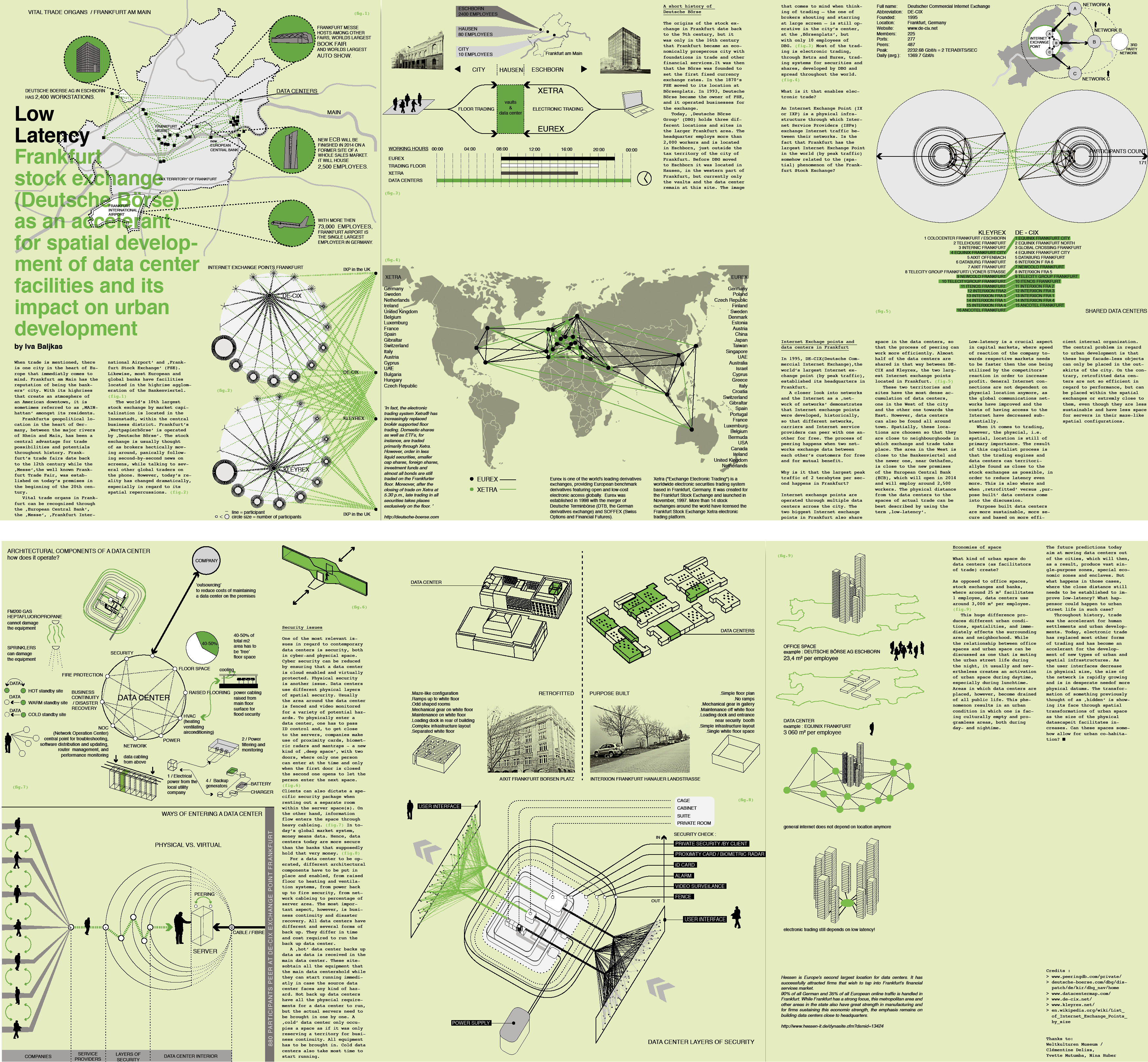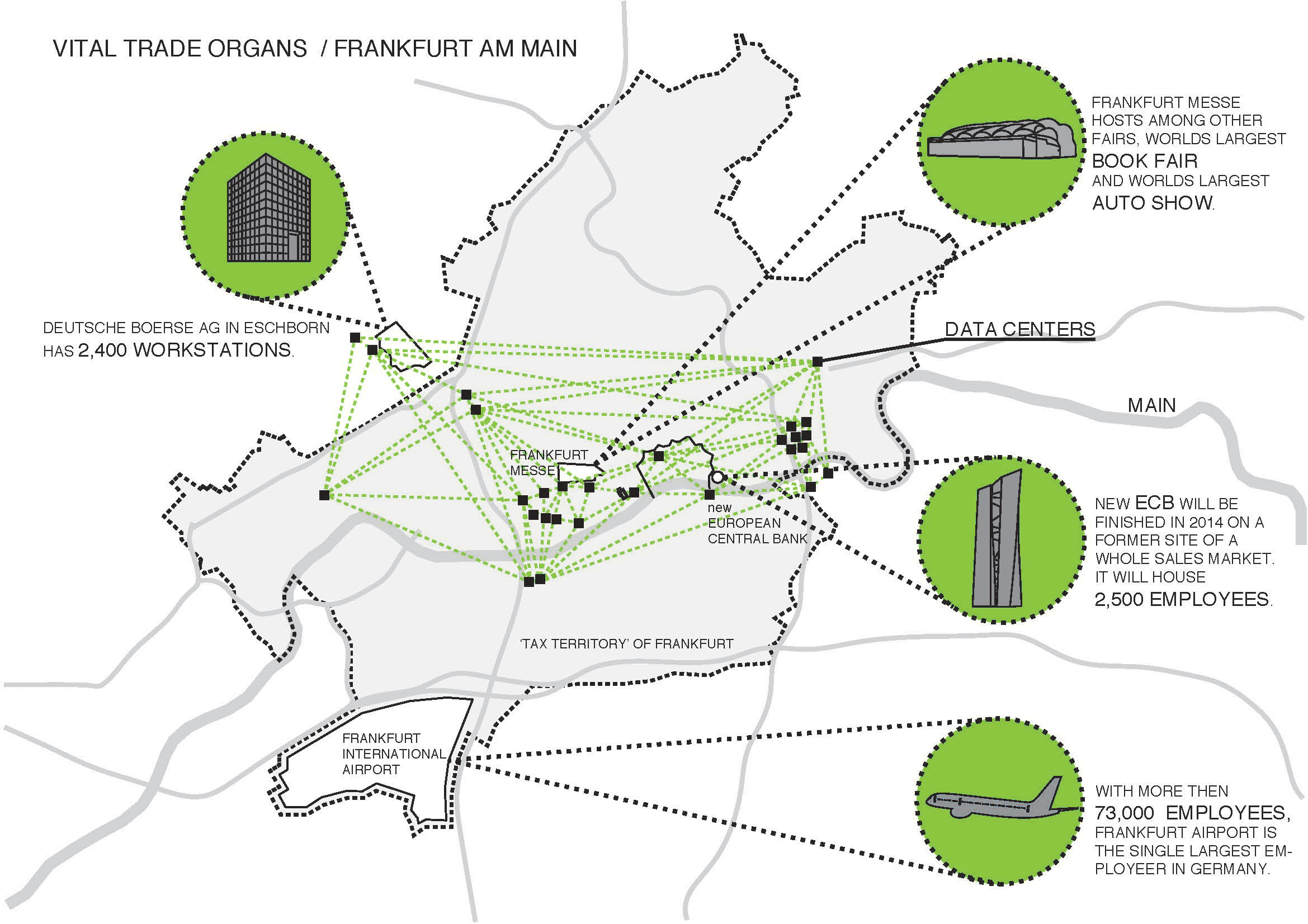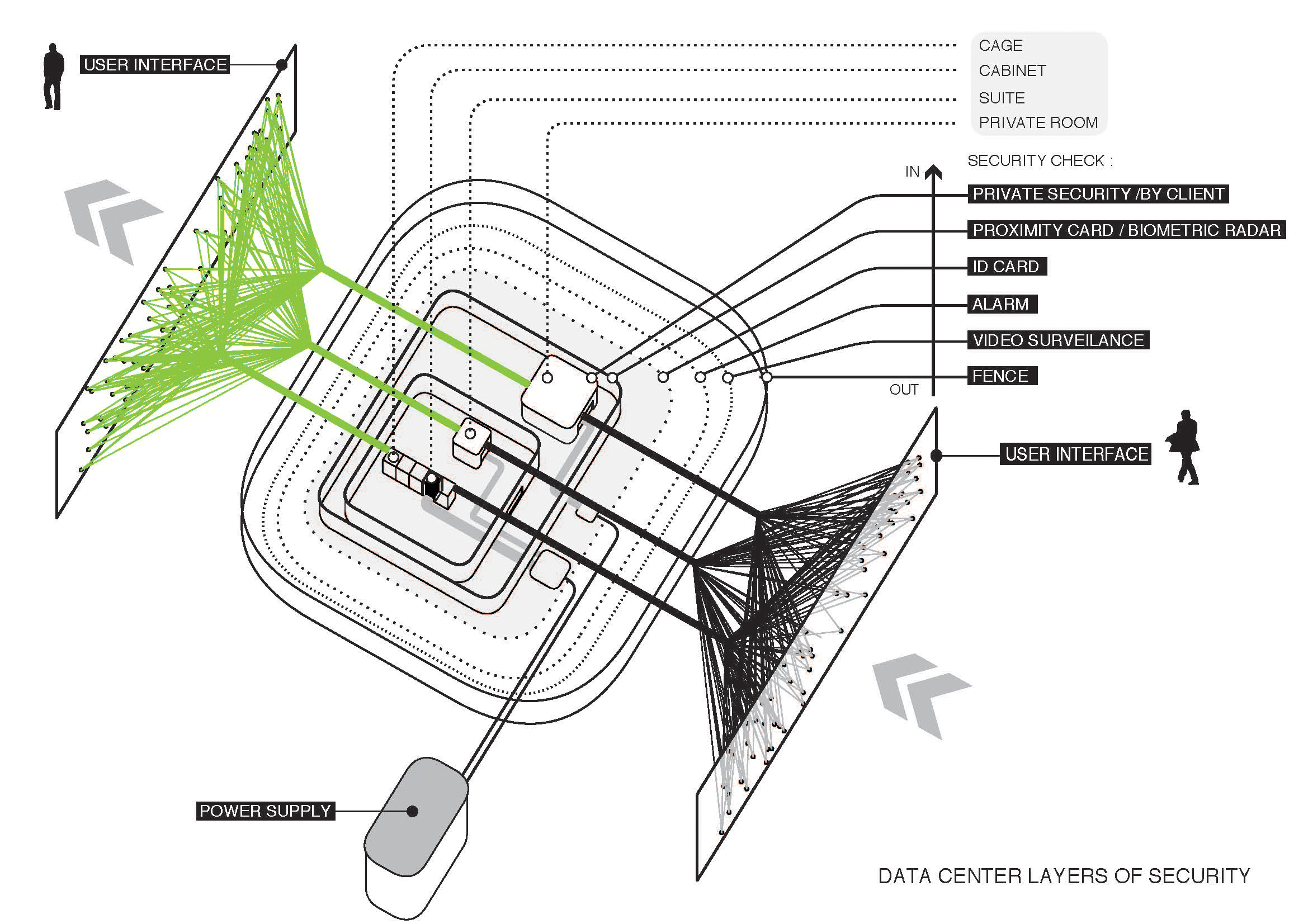Frankfurt stock exchange (Deutsche Börse) as an accelerant for spatial development of data center facilities and its impact on urban development
Stealth Architecture Newsprint
Städelschule Rundgang 2013

When trade is mentioned, there is one city in the heart of Europe that immediately comes to mind. Frankfurt am Main has the reputation of being the bankers’ city. With its high rises that create an atmosphere of an American downtown, it is sometimes referred to as 'MAINhattan' amongst its residents. Frankfurts geopolitical location in the heart of Germany, between the major rivers of Rhein and Main, has been a central advantage for trade possibilities and potentials throughout history. Frankfurt's trade fairs date back to the 12th century while the 'Messe', the well known Frankfurt Trade Fair, was established on today's premises in the beginning of the 20th century.
Vital trade organs in Frankfurt can be recognised through the 'European Central Bank', the 'Messe', 'Frankfurt International Airport' and 'Frankfurt Stock Exchange' (FSE). Likewise, most European and global banks have facilities located in the high-rise agglomeration of the Bankenviertel.

The world's 10th largest stock exchange by market capitalisation is located in the Innenstadt, within the central business district. Frankfurt's'WertpapierBörse' is operated by 'Deutsche Börse'. The stock exchange is usually thought of as brokers hectically moving around, panically following second-by-second news on screens, while talking to several other global traders on the phone. However, today's reality has changed dramatically, especially in regard to its spatial repercussions.
A short history of Deutsche Börse
The origins of the stock exchange in Frankfurt date back to the 9th century, but it was only in the 16th century that Frankfurt became an economically prosperous city with foundations in trade and other financial services. It was then that the Börse was founded to set the first fixed currency exchange rates. In the 1870's FSE moved to its location at Börsenplatz. In 1993, Deutsche Börse became the owner of FSE, and it operated businesses for the exchange.
Today, 'Deutsche Börse Group' (DBG) holds three different locations and sites in the larger Frankfurt area. The headquarter employs more than 2'000 workers and is located in Eschborn, just outside the tax territory of the city of Frankfurt. Before DBG moved to Eschborn it was located in Hausen, in the western part of Frankfurt, but currently only the vaults and the data center remain at this site. The image that comes to mind when thinking of trading – the one of brokers shouting and starring at large screen – is still operative in the city's center, at the 'Börsenplatz', but with only 10 employees of DBG. Most of the trading is electronic trading, through Xetra and Eurex, trading systems for securities and shares, developed by DBG and spread throughout the world.
What is it that enables electronic trade?
An Internet Exchange Point (IX or IXP) is a physical infrastructure through which Internet Service Providers (ISPs) exchange Internet traffic between their networks. Is the fact that Frankfurt has the largest Internet Exchange Point in the world (by peak traffic) somehow related to the (spatial) phenomenon of the Frankfurt Stock Exchange?
Internet Exchage points and data centers in Frankfurt
In 1995, DE-CIX(Deutsche Commercial Internet Exchange),the world's largest Internet exchange point (by peak trafic), established its headquarters in Frankfurt.
A closer look into networks and the Internet as a 'network of networks' demonstrates that Internet exchange points were developed, historically, so that different networks, carriers and Internet service providers can peer with one another for free. The process of peering happens when two networks exchange data between each other's customers for free and for mutual benefit.
Why is it that the largest peak traffic of 2 terabytes per second happens in Frankfurt?
Internet exchange points are operated through multiple data centers across the city. The two biggest Internet exchange points in Frankfurt also share space in the data centers, so that the process of peering can work more efficiently. Almost half of the data centers are shared in that way between DE-CIX and Kleyrex, the two largest Internet exchange points located in Frankfurt.
These two territories and sites have the most dense accumulation of data centers, one in the West of the city and the other one towards the East. However, data centers can also be found all around town. Spatially, these locations are chosen so that they are close to neighbourhoods in which exchange and trade take place. The area in the West is close to the Bankenviertel and the newer one, near Osthafen, is close to the new premises of the European Central Bank (ECB), which will open in 2014 and will employ around 2'500 workers. The physical distance from the data centers to the spaces of actual trade can be best described by using the term 'low-latency'.
Low-latency is a crucial aspect in capital markets, where speed of reaction of the company towards respective markets needs to be faster then the one being utilised by the competitors' reaction in order to increase profit. General Internet connections are not dependent on physical location anymore, as the global communications networks have improved and the costs of having access to the Internet have decreased substantially.
When it comes to trading, however, the physical, i.e. spatial, location is still of primary importance. The result of this capitalist process is that the trading engines and data centers can territorially be found as close to the stock exchanges as possible, in order to reduce latency even more. This is also where and when 'retrofitted' versus 'purpose built' data centers come into the discussion.
Purpose built data centers are more sustainable, more secure and based on more efficient internal organisation. The central problem in regard to urban development is that these huge facade-less objects can only be placed in the outskirts of the city. On the contrary, retrofitted data centers are not so efficient in regard to performance, but can be placed within the spatial exchanges or extremely close to them, even though they are less sustainable and have less space for servers in their maze-like spatial configurations.
Security issues
One of the most relevant issues in regard to contemporary data centers is security, both in cyber-and physical space. Cyber security can be reduced by ensuring that a data center is cloud enabled and virtually protected. Physical security is another issue. Data centers use different physical layers of spatial security. Usually the area around the data center is fenced and video monitored for a variety of potential hazards. To physically enter a data center, one has to pass ID control and, to get close to the servers, companies make use of proximity cards, biometric radars and mantraps - a new kind of 'deep space', with two doors, where only one person can enter at the time and only when the first door is closed the second one opens to let the person enter the next space.

Clients can also dictate a specific security package when renting out a separate room within the server space(s). On the other hand, information flow enters the space through heavy cabling. In today's global market system, money means data. Hence, data centers today are more secure than the banks that supposedly hold that very money.
For a data center to be operated, different architectural components have to be put in place and enabled, from raised floor to heating and ventilation systems, from power back up to fire security, from network cabling to percentage of server area.The most important aspect, however, is business continuity and disaster recovery. All data centers have different and several forms of back up. They differ in time and cost required to run the back up data center.
A 'hot' data center backs up data as data is received in the main data center. These sites obtain all the equipment that the main data centers hold while they can start running immediately in case the source data center faces any kind of hazard. Hot back up data centers have all the physical requirements for a data center to run, but the actual servers need to be brought in one by one.A 'cold' data center only occupies a space as if it was only reserving a territory for business continuity. All equipment has to be brought in. Cold data centers also take more time to start running.

Economies of space
What kind of urban space do data centers (as facilitators of trade) create? As opposed to office spaces, stock exchanges and banks, where around 25m2 facilitates 1 employee, data centers use around 3,000 m2 per employee.
This huge difference produces different urban conditions, spatialities, and immediately effects the surrounding area and neighbourhood. While the relationship between office spaces and urban space can be discussed as one that is muting the urban street life during the night, it usually and nevertheless creates an activation of urban space during daytime, especially during lunchtime. Areas in which data centers are placed, however, become drained of all public life. This phenomenon results in an urban condition in which one is facing culturally empty and program less areas, both during day- and night time.
The future predictions today aim at moving data centers out of the cities, which will then, as a result, produce vast single-purpose zones, special economic zones and enclaves. But what happens in those cases, where the close distance still needs to be established to improve low-latency? What would happen to urban street life in such case?

Throughout history, trade was the accelerant for human settlements and urban developments. Today, electronic trade has replaced most other forms of trading and has becom an accelerant for the development of new types of urban and spatial infrastructures. As the user interfaces decrease in physical size, the size of the network is rapidly growing and is in desperate need of more physical datums. The transformation of something previously thought of as 'hidden' is showing its face through spatial transformations of urban space as the size of the physical datascape it facilitates increases. Can these spaces somehow allow for urban co-habitation?
︎
https://www.peeringdb.com/private/
http://deutsche-boerse.com/dbg/dispatch/de/kir/dbg_nav/home
http://www.datacentermap.com/
http://www.de-cix.net/
http://www.kleyrex.net/
Thanks to: Weltkulturen Museum / Clementine Deliss, Yvette Mutumba, Nina Huber